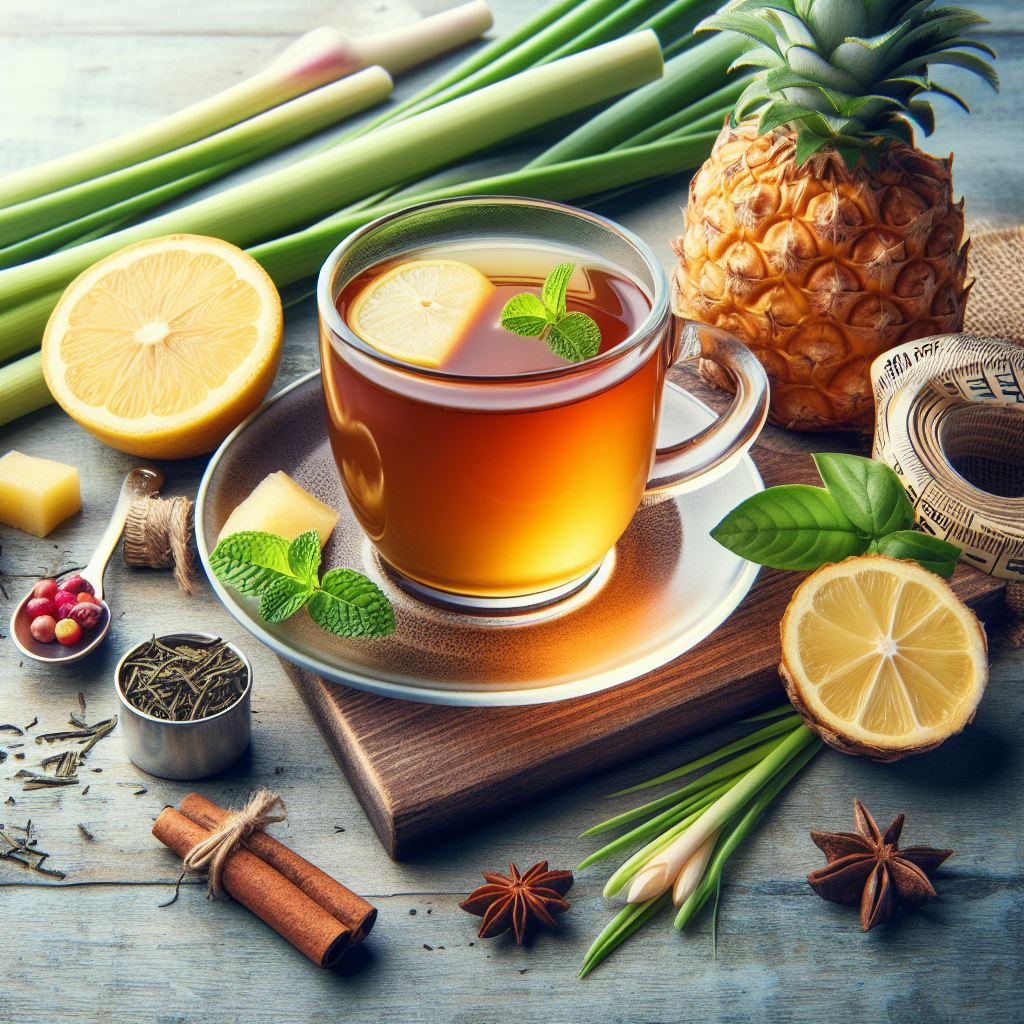If you are looking for a tea that can transport you to a world of floral bliss, look no further than osmanthus tea. Osmanthus tea is a traditional Chinese tea that is made from the dried flowers of the osmanthus plant. It has a unique and captivating aroma that resembles apricots, peaches, or jasmine.
Not only is it delicious, It also has a range of health benefits and cultural significance that makes it more interesting than your average tea! In this article, we will explore the allure and history of osmanthus tea, as well as how to brew it, enjoy it, and use it in various ways.

Origins and Cultural Significance
Osmanthus tea has a long and rich history that dates back to ancient China. According to legend, it was first discovered by the mythical emperor Shennong, who is credited with inventing agriculture and herbal medicine. He was so impressed by the fragrance and flavor of osmanthus tea that he named it “guihua cha”, which means “sweet-scented flower tea” in Chinese.
The Chinese Culture
Osmanthus tea has been revered in Chinese culture for centuries, not only for its taste and aroma, but also for its symbolic and medicinal value. Osmanthus flowers are associated with elegance, nobility, happiness, and love.
They are often used in traditional Chinese medicine to treat various ailments, such as coughs, colds, indigestion, and skin problems. Not only this, they have also been used in art and literature to express beauty and romance. For example, one of the most famous poems in Chinese history, “Birds Calling in the Ravine” by Wang Wei, praises the osmanthus flower for its grace and charm.
Chinese Culinary Traditions
Osmanthus tea is also an integral part of Chinese culinary traditions, especially during festivals and celebrations. It is commonly served as a welcome drink to guests or as a toast to auspicious occasions.
The tea is often used to flavor various dishes and desserts, such as mooncakes, dumplings, cakes, and puddings. One of the most popular delicacies made with osmanthus tea is osmanthus jelly, which is a sweet and refreshing treat that is enjoyed during the Mid-Autumn Festival.
About The Osmanthus Plant
The osmanthus plant belongs to the olive family and is native to Asia. It is an evergreen shrub or small tree that can grow up to 12 meters tall, with dark green leaves and clusters of small yellow or white flowers that bloom in autumn. The flowers have a strong and pleasant fragrance that can fill the air for miles around.
Varieties
There are many varieties of osmanthus plants, but the most common ones used for tea production are Osmanthus fragrans and Osmanthus heterophyllus.
Osmanthus fragrans is also known as sweet osmanthus or fragrant olive, and it has yellow or orange flowers that have a fruity scent. Whereas, osmanthus heterophyllus is also known as holly osmanthus or false holly, and it has white flowers that have a jasmine-like scent.

Cultivation
Osmanthus plants are cultivated in warm and humid regions, such as southern China, Taiwan, Japan, Korea, Vietnam, and Thailand. They prefer well-drained soil and partial shade.
You would likely see them being harvested in late summer or early autumn when the flowers are fully bloomed. The flowers are then dried in the sun or by artificial heat until they turn brownish-yellow. Dried osmanthus flowers can be stored for up to a year without losing their fragrance or flavor.
Discover more about how tea is cultivated and processed.
Where to Get Osmanthus Tea?
You might be wondering where to get osmathus for your tea? Especially since it is such unique and uncommon type of flower. Well, not to worry! There are several ways to get osmanthus tea, depending on your preference and availability. Here are some of the best options:
Online
One of the easiest and most convenient ways to get osmanthus tea is to order it online. There are many online stores that sell osmanthus tea, either as pure osmanthus flowers or as blends with other teas, such as green tea or jasmine tea. You can just browse through different varieties, prices, and reviews, and choose the one that suits your taste and budget. Some of the online stores are:
- Amazon: Amazon is a well-known and reliable online marketplace that offers a wide range of tea products, including osmanthus tea. You can find different brands, sizes, and flavors of osmanthus tea on Amazon, such as TooGet Fragrant Osmanthus Fragrans Herb Loose Leaf Tea, ELITEA 4oz Dried Osmanthus Flower Herb Loose Leaf Tea, or Cha Wu-Osmanthus & Oolong Tea Bags.
- Tea Life: Tea Life is an online store that specializes in organic loose leaf tea from Australia. They offer high-quality and fresh osmanthus tea that is sourced from reputable suppliers. You can buy osmanthus tea in different quantities, such as 50g, 100g, or 200g, and enjoy free shipping on orders over $60.
- Wilson Bros Gardens: Wilson Bros Gardens is an online nursery that sells plants, trees, shrubs, and flowers for your garden. They also sell osmanthus tea olive trees, which are cold hardy shrubs that produce white fragrant flowers in the fall. You can buy osmanthus tea olive trees in different sizes, such as 2.25 gallon or 7 gallon, and enjoy free shipping on orders over $125. You can also read detailed descriptions and care instructions for the plants on their website.
Speciality Stores
Another way to get osmanthus tea is to visit specialty stores that sell teas, herbs, spices, or health products. These stores may have a selection of osmanthus tea or flowers that you can buy in bulk or pre-packaged. You may also be able to sample the tea before buying it or ask for advice from the staff. Some of the specialty stores are:
- Teavana: Teavana is a chain of stores that sells premium loose leaf teas, teaware, and accessories. They have a variety of teas from different regions and cultures, such as black, green, white, oolong, herbal, and flavored teas. They may have osmanthus tea or blends that contain osmanthus flowers, such as Osmanthus Oolong Tea or Jasmine Dragon Phoenix Pearls Green Tea. You can also enjoy a free cup of tea with any purchase at Teavana!
- The Spice & Tea Exchange: The Spice & Tea Exchange is a chain of stores that sells spices, herbs, salts, sugars, teas, gifts, and accessories. They have a variety of teas from different categories and flavors, such as black, green, white, oolong,
How to Brew Osmanthus Tea
Once you have your osmanthus sourced and ready, it’s time to brew! Brewing osmanthus tea is easy and enjoyable, much like brewing a regular ‘everyday’ tea. However, there are also many other ways to experiment with the osmanthus plant to get different experiences and flavors. To start with, here is the most basic and simple way to enjoy your tea:
- Prepare a teapot or infuser with boiling water.
- Add about one teaspoon of dried osmanthus flowers per cup of water.
- Steep for about 3 to 5 minutes, depending on your preference.
- Enjoy your tea hot or cold.

Alternative Ways to Brew Osmanthus Tea:
1. Combine with Other Teas
Another interesting way to enhance the flavor and fragrance of your osmanthus tea is to combine it with other teas, such as green tea or jasmine tea. This will create a more complex and balanced taste that can suit different moods and occasions. For example, you can try mixing osmanthus tea with:
- Green tea: This will add a refreshing and grassy note to your osmanthus. The green tea leaves also have many health benefits, such as boosting metabolism and immunity, or even strengthening your hair. Try using a mild and smooth green tea, such as longjing or sencha, to avoid overpowering the osmanthus flavor.
- Jasmine tea: This will add a floral and sweet note to your osmanthus tea. Jasmine tea also has a calming and soothing effect, making it ideal for relaxing and unwinding. Try using a high-quality jasmine tea, such as jasmine pearls or silver needle, to ensure a natural and delicate aroma.
2. Cold-brew Osmanthus Tea
If you prefer cold and refreshing teas, you can try experiment with cold-brewing. Cold-brewing is a method of steeping tea leaves or flowers in cold water for several hours or overnight. This will result in a smoother and less bitter taste, as well as a higher concentration of antioxidants and other beneficial compounds. To cold-brew this tea, simply:
- Place about two teaspoons of dried osmanthus flowers in a glass jar or bottle (combine with some tea leaves for a stronger taste).
- Fill it with cold water and seal it tightly.
- Refrigerate it for at least 8 hours or overnight.
- Strain and enjoy your cold-brewed osmanthus tea.
Find out more about Cold Brew Tea: The Ultimate Guide for Refreshing Tea Lovers
3. Combine Other Ingredients
Lastly, you can try create your own herbal tea blends by adding osmanthus flowers to other ingredients, such as herbs, spices, fruits, or nuts. This will allow you to customize your tea according to your preferences and creativity, and increase the health benefits. For example, you can try adding osmanthus flowers to:
- Chamomile: This will create a soothing and relaxing blend that can help you sleep better and reduce stress. Chamomile also has anti-inflammatory and antibacterial properties that can benefit your skin and digestion.
- Ginger: This will create a warming and stimulating blend that can boost your energy and immunity. Ginger also has anti-nausea and anti-inflammatory properties, making it one of the best teas to help you cope with colds and flu.
- Rose: This will create a romantic and elegant blend that can uplift your mood and inspire love. Rose also has anti-aging and anti-depressant properties that can improve your skin and mental health.
Health Benefits of Osmanthus Tea
Osmanthus tea is not only delicious and fragrant, but also healthy and beneficial. Much like other flowers and herbal teas, the osmathus flower can be used to help with relaxation and digestion. Below are some of the potential health benefits associated with the tea:

Health Benefits:
- Antioxidant: Osmanthus tea is rich in antioxidants, such as flavonoids, phenolic acids, and essential oils. These compounds can help protect your cells from oxidative stress and damage caused by free radicals. They can also prevent or delay the onset of chronic diseases, such as cancer, diabetes, and cardiovascular problems.
- Digestive: Osmanthus tea can help improve your digestion and metabolism by stimulating the secretion of digestive enzymes and bile. It can also help relieve constipation, bloating, gas, and indigestion by relaxing the smooth muscles of the gastrointestinal tract. Additionally, it can help prevent or treat intestinal infections by inhibiting the growth of harmful bacteria.
- Stress-relieving: Osmanthus tea can help reduce stress and anxiety by modulating the activity of the nervous system. It can also help improve your mood and cognitive function by increasing the levels of serotonin and dopamine in the brain. Furthermore, it can help promote sleep quality and duration by inducing relaxation and sedation.
History in Traditional Chinese Medicine:
As you can see, osmanthus is a great natural remedy for relaxation and detoxing. However, interestingly, osmanthus tea has been used for centuries in traditional Chinese medicine to treat various ailments. Some of the notable historical or cultural anecdotes related to the medicinal use of osmanthus are:
- During the Tang dynasty (618-907 AD), osmanthus tea was considered a royal drink that was reserved for the emperor and his courtiers. It was believed that this tea could enhance longevity, beauty, and wisdom.
- During the Ming dynasty (1368-1644 AD), osmanthus tea was used as a remedy for scurvy, a disease caused by vitamin C deficiency. It was also used as a tonic for the lungs, kidneys, liver, and spleen.
- During the Qing dynasty (1644-1912 AD), osmanthus tea was used as a preventive measure against epidemics, such as cholera and typhoid. It was also used as an antidote for snake bites and poisonings.
Culinary Uses and Pairings
Osmanthus tea is not only a delightful drink, but also a versatile ingredient that can be used in various cuisines. Osmanthus flowers have a sweet and floral flavor that can enhance the taste and aroma of many dishes and desserts. See below for some of the culinary applications of osmanthus:

1. Desserts:
Osmanthus flowers can be used to make delicious desserts, such as cakes, cookies, puddings, ice creams, jellies, candies, and chocolates. They can add a subtle floral note that complements the sweetness of these treats. One of the most popular desserts made with osmanthus flowers is osmanthus jelly, which is a sweet and refreshing treat that is enjoyed during the Mid-Autumn Festival. To make osmanthus jelly, you will need:
- 4 cups of water
- 1/4 cup of dried osmanthus flowers
- 1/4 cup of rock sugar
- 2 tablespoons of agar-agar powder
Steps:
- Bring the water to a boil in a pot and add the osmanthus flowers and rock sugar. Simmer for about 15 minutes until the sugar dissolves and the flowers release their fragrance.
- Dissolve the agar-agar powder in a small bowl of cold water and add it to the pot. Stir well and bring to a boil again.
- Pour the mixture into a shallow dish or mold and let it cool and set in the refrigerator for at least 4 hours or overnight.
- Cut into pieces and serve chilled or at room temperature.
2. Pastries:
Osmanthus flowers can also be used to make pastries, such as breads, muffins, scones, and croissants. They can add a delicate and aromatic touch to these baked goods. One of the easiest ways to use osmanthus flowers in pastries is to infuse them into butter or cream and use them as ingredients or toppings. To make osmanthus butter, you will need:
- 1/2 cup of unsalted butter
- 2 tablespoons of dried osmanthus flowers
- A pinch of salt
Steps:
- Melt the butter in a small saucepan over low heat and add the osmanthus flowers and salt. Stir well and simmer for about 10 minutes until the butter is infused with the floral flavor.
- Strain the butter through a fine-mesh sieve or cheesecloth and discard the flowers.
- Transfer the butter to a jar or container and refrigerate until solid.
- Use the osmanthus butter as a spread for breads, muffins, scones, or croissants.
3. Beverages:
Osmanthus flowers can also be used to make beverages, such as teas, coffees, smoothies, and mocktails. They can add a refreshing and fragrant twist to these drinks. One of the most popular beverages made with osmanthus flowers is osmanthus milk tea, which is a creamy and soothing drink that can be enjoyed hot or cold. To make osmanthus milk tea, you will need:
- 2 cups of water
- 2 tablespoons of dried osmanthus flowers
- 2 black tea bags
- 1/4 cup of condensed milk
- Ice cubes (optional)
Steps:
- Bring the water to a boil in a pot and add the osmanthus flowers. Simmer for about 15 minutes until the water is infused with the floral aroma.
- Add the black tea bags and steep for about 5 minutes until the tea is strong enough.
- Remove the tea bags and strain the tea through a fine-mesh sieve or cheesecloth and discard the flowers.
- Stir in the condensed milk and adjust the sweetness according to your taste.
- Enjoy your osmanthus milk tea hot or cold with ice cubes if desired.
Osmanthus Tea in Modern Culture
Osmanthus tea is not only a traditional Chinese tea, but also a modern and trendy tea that has gained popularity in Western countries and other parts of the world. It has been integrated into contemporary tea culture and has inspired many unique products and innovations related to osmanthus. See below for some examples of how osmanthus has influenced modern culture:

1. Osmanthus candles:
Osmanthus tea can also be used to make candles, which can fill your home with a pleasant and relaxing fragrance. These candles can create a cozy and romantic atmosphere that can soothe your senses and calm your mind. To make osmanthus candles, you will need:
- 1 cup of soy wax flakes
- 2 tablespoons of dried osmanthus flowers
- A candle wick
- A glass jar or container
- A microwave-safe bowl
- A wooden spoon
- A pair of scissors
Steps:
- Place the soy wax flakes in the microwave-safe bowl and microwave for about 2 minutes or until melted. Stir well with the wooden spoon.
- Add the osmanthus flowers and stir well again. Let the mixture cool slightly.
- Place the candle wick in the center of the glass jar or container and secure it with a dab of wax or glue.
- Carefully pour the wax mixture into the jar or container, leaving some space at the top. Make sure that the wick is straight and centered.
- Let the candle set and harden for at least 4 hours or overnight.
- Trim the wick to about half an inch and light your osmanthus candle.
Find out more about how to make tea-infused candles.
2. Osmanthus beauty products:
Osmanthus tea can also be used to make beauty products, such as creams, lotions, masks, scrubs, and perfumes. These types of beauty products can benefit your skin and hair by moisturizing, nourishing, brightening, and smoothing them. They can also give you a natural and subtle glow that can enhance your appearance and confidence. To make osmanthus cream, you will need:
- 1/4 cup of shea butter
- 2 tablespoons of coconut oil
- 1 tablespoon of dried osmanthus flowers
- A double boiler or a heatproof bowl over a pot of simmering water
- A blender or a food processor
- A glass jar or container with a lid
Steps:
- Place the shea butter, coconut oil, and osmanthus flowers in the double boiler or heatproof bowl and melt them over low heat. Stir well until smooth and combined.
- Transfer the mixture to the blender or food processor and blend until fluffy and creamy.
- Spoon the cream into the glass jar or container and seal it tightly.
- Store your osmanthus cream in the refrigerator for up to a month.
- Use your osmanthus cream as a moisturizer for your face and body.
Conclusion
Osmanthus tea is a fragrant and flavorful delight that can offer you many benefits and pleasures. This tea has a long and rich history, as well as a modern and trendy appeal. It is a tea that can be brewed, enjoyed, and used in various ways. It is a tea that can transport you to a world of floral bliss.
We hope that this blog post has inspired you to explore and experience the beauty and allure of osmanthus tea. Whether you drink it, eat it, smell it, or apply it, osmanthus can enhance your well-being and mindfulness.
Have you ever tried osmanthus tea? What are your favorite ways to use osmanthus? Do you have any osmanthus tea stories or recipes to share? Let us know in the comments below!
Check Out More Tea-Related Articles:
- The Ultimate Sugar Honey Iced Tea: A Sweet and Sassy Drink
- How to Make Sage Tea: A Guide to the Magical World of Sage
- How to Make Dandelion Tea: A Step-by-Step Guide
- Oolong Tea Benefits and Beyond: Everything You Need to Know
- How to Make Sparkling Tea: A Bubbly Twist to Your Tea Experience





Leave a Comment